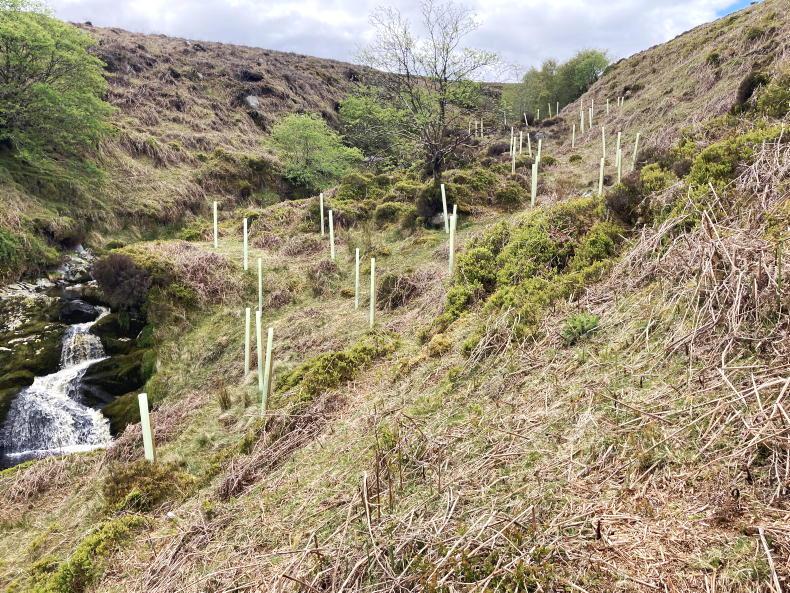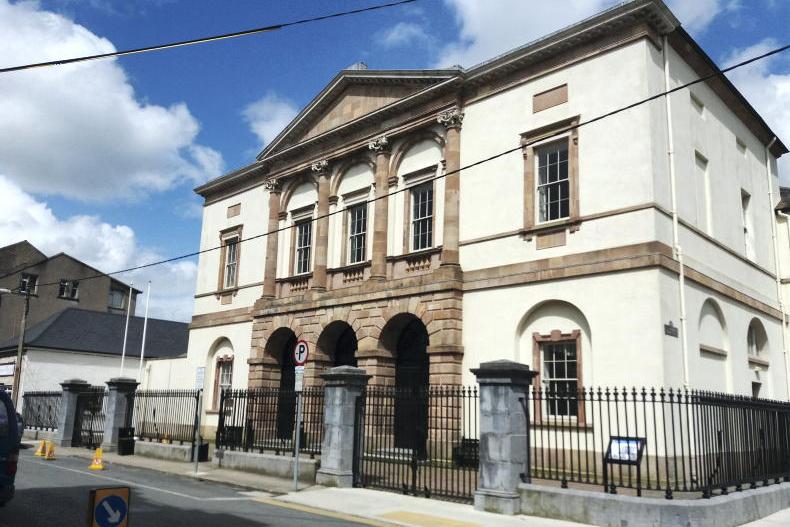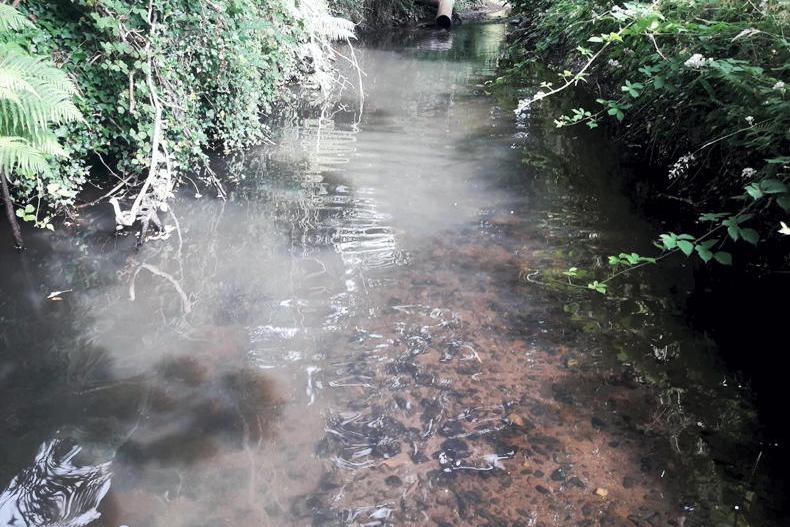The Sustainable Uplands Agri-Environmental Scheme (SUAS) will take on a new tranche of participants this year.
The scheme is funded by the Department of Agriculture via the European Innovation Partnership for agricultural productivity and sustainability (EIP-Agri).
It aims to set goals for farmers on habitat management, but very importantly, it has a broader plan for the area so that individual farm plans work to meet the overall goals of the project in that area.
SUAS is unique in that it has set out to address many of the challenges of implementing an agri-environment scheme across commonage lands and hopes at the end of the project to deliver a model for a locally led, targeted and results-based agri-environmental scheme that can be rolled out over other Irish commonages and upland areas.

Native tree planting along Slade Brook, which flows into Bohernabreena Resevoir.
Application call
Applications must be submitted by 2 July and those accepted will join a commonage group. Participants will receive training on habitat management and learn how to draw up a management plan for farm uplands, which may prove useful under the next CAP.
Support will be provided to complete simple habitat improvement measures on farms and to make improvements as a collective group of commonage farmers working together.
The SUAS project is keen for farmers to bring their own ideas forward as they are the ones with the insight into the hills.
The five-year project will finish in 2022 so projects will need to be completed in one year.
Landscape level planning
The SUAS project is based in the Dublin and Wicklow Mountains. The uplands involved are open areas which, as the project manager Declan Byrne explains, contain a mosaic of different habitats and are affected by different pressures.
The project sets out an aim for landscape level and then sets priorities and plans actions for individual farms or LPIS plots.
Declan explained: “This ensures coordinated delivery of the required management over the whole target area, rather than just hoping individual farmers all choose the correct actions on their own areas and these fit in with what their neighbours are doing.”
Declan added that previous environmental schemes have attempted to deal with shareholders in commonages as individuals and this resulted in a lack of coordination in the planning and delivery of these plans.
While farmers receive help and advice in the early stages of their management plans, the focus then turns to rewarding farmers for delivering habitat management.
The SUAS project introduced a habitat score-based payment system in 2020. This system is not easy, as there are multiple herd owners to deal with and other things like the time lag between actions carried out and the improvements in habitat quality.
Declan noted: “While these habitat score-based payments will not solve all our problems, they do reward current and past management and should form part of any payment system going forward.”
Examples of some of the vegetation management actions delivered in SUAS are outlined below.
It is important to note that actions chosen are specific to each site and are trialled with consideration of the practicalities of carrying out the action and the costs involved.
Examples of actions carried out:
Appropriate grazing by livestock.Controlled burning.Mulching/cutting by suitable machines.Cutting/mulching by hand (brush cutters and chainsaws).Bracken spraying, with machines and by hand.Bracken bruising.Rhododendron control.Access repairs.Fencing exclusion zones.Upland gully planting.Active shepherding.Declan Byrne: “While the money invested in agri-environmental schemes can contribute to farm income, it should only be paid for actual delivery of habitat management rather than as a form of income support.
“Farmers would then treat it like another farm enterprise or another product that they can produce on their farm, and it is up to them to decide if the rewards or payments are worth their while or not.”
If you are interested in participating in the SUAS project you can visit the website.
The Sustainable Uplands Agri-Environmental Scheme (SUAS) will take on a new tranche of participants this year.
The scheme is funded by the Department of Agriculture via the European Innovation Partnership for agricultural productivity and sustainability (EIP-Agri).
It aims to set goals for farmers on habitat management, but very importantly, it has a broader plan for the area so that individual farm plans work to meet the overall goals of the project in that area.
SUAS is unique in that it has set out to address many of the challenges of implementing an agri-environment scheme across commonage lands and hopes at the end of the project to deliver a model for a locally led, targeted and results-based agri-environmental scheme that can be rolled out over other Irish commonages and upland areas.

Native tree planting along Slade Brook, which flows into Bohernabreena Resevoir.
Application call
Applications must be submitted by 2 July and those accepted will join a commonage group. Participants will receive training on habitat management and learn how to draw up a management plan for farm uplands, which may prove useful under the next CAP.
Support will be provided to complete simple habitat improvement measures on farms and to make improvements as a collective group of commonage farmers working together.
The SUAS project is keen for farmers to bring their own ideas forward as they are the ones with the insight into the hills.
The five-year project will finish in 2022 so projects will need to be completed in one year.
Landscape level planning
The SUAS project is based in the Dublin and Wicklow Mountains. The uplands involved are open areas which, as the project manager Declan Byrne explains, contain a mosaic of different habitats and are affected by different pressures.
The project sets out an aim for landscape level and then sets priorities and plans actions for individual farms or LPIS plots.
Declan explained: “This ensures coordinated delivery of the required management over the whole target area, rather than just hoping individual farmers all choose the correct actions on their own areas and these fit in with what their neighbours are doing.”
Declan added that previous environmental schemes have attempted to deal with shareholders in commonages as individuals and this resulted in a lack of coordination in the planning and delivery of these plans.
While farmers receive help and advice in the early stages of their management plans, the focus then turns to rewarding farmers for delivering habitat management.
The SUAS project introduced a habitat score-based payment system in 2020. This system is not easy, as there are multiple herd owners to deal with and other things like the time lag between actions carried out and the improvements in habitat quality.
Declan noted: “While these habitat score-based payments will not solve all our problems, they do reward current and past management and should form part of any payment system going forward.”
Examples of some of the vegetation management actions delivered in SUAS are outlined below.
It is important to note that actions chosen are specific to each site and are trialled with consideration of the practicalities of carrying out the action and the costs involved.
Examples of actions carried out:
Appropriate grazing by livestock.Controlled burning.Mulching/cutting by suitable machines.Cutting/mulching by hand (brush cutters and chainsaws).Bracken spraying, with machines and by hand.Bracken bruising.Rhododendron control.Access repairs.Fencing exclusion zones.Upland gully planting.Active shepherding.Declan Byrne: “While the money invested in agri-environmental schemes can contribute to farm income, it should only be paid for actual delivery of habitat management rather than as a form of income support.
“Farmers would then treat it like another farm enterprise or another product that they can produce on their farm, and it is up to them to decide if the rewards or payments are worth their while or not.”
If you are interested in participating in the SUAS project you can visit the website.











SHARING OPTIONS